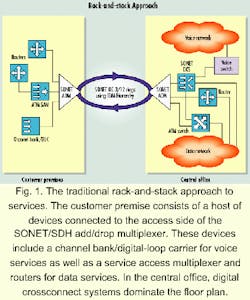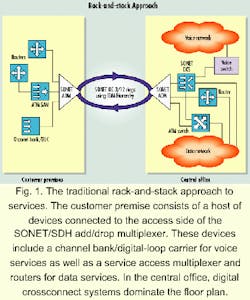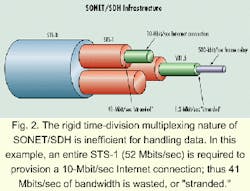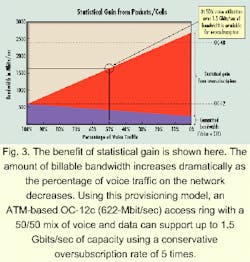Delivering integrated services over access networks
Multiservice transport equipment reduces the cost and complexity of integrated access networks, replacing SONET/SDH with ATM transport.
In a push to deliver advanced voice and data services, local-exchange carriers (LECs) are re-evaluating the traditional architecture for building access networks. A new class of network equipment called "multiservice transport elements" allow LECs to merge the functionality of transport and access equipment, while dramatically reducing the cost and complexity of delivering services.
Equipment vendors have taken differing approaches to the architecture of these new elements. Most, however, share the objective of providing integrated services in a single, space-saving system that makes efficient use of bandwidth via packet and/or cell technology.
With collocation charges in some areas reaching up to $400 per sq ft, competitive carriers are very sensitive to the size and number of devices they put in incumbent LECs' collocation cages. Competitive LECs need to amortize the recurring cost of the collocation rent over as many services as possible. As a result, the "rack-and-stack" approach to delivering services doesn't offer much appeal.
By deploying multiservice transport elements, carriers can condense the space requirements for services, and depending on density, reduce the cost basis. Since the savings from an integrated platform are recurring, the payback on the equipment cost is much faster than with traditional network elements.
Adding service-specific network elements also creates a host of ancillary activities that eat into carriers' profitability. The technical staff requires installation and maintenance training on each new device and must stock spare devices. Operators need training on the provisioning model as well as fault isolation and management applications. In addition, they must integrate the device into their billing and operation-support-system (OSS) infrastructure. Once this integration is complete, the battle is only half won. The manual provisioning of these multiple devices translates into a longer lead time for service delivery.
On a multiservice transport network, the addition of services doesn't require new OSS applications or retraining, because most applications are implemented as modules on the element. This advantage increases the speed at which services can be deployed and eliminates the lost revenue associated with long lead times.
Although SONET/SDH technology offers 50-msec restoration and performance-monitoring functions, it is based on a rigid hierarchical structure and point-to-point provisioning model. As demand for advanced data services increases, LECs have found that SONET/SDH-based access networks are not well suited to carry this type of traffic. Virtually every public and private network segment is using some packet and/or cell technology, making SONET/SDH the last bottleneck on the Internet.One reason for this bottleneck is that time-division multiplexing (TDM)-based SONET/SDH cannot take advantage of the statistical multiplexing capability of packet and cell technologies. Since bandwidth provisioning on SONET/SDH is based on fixed timeslots, allocating bandwidth in usable chunks is very difficult. For example, to provision a 10-Mbit/sec Internet connection across a SONET/SDH TDM infrastructure, an entire STS-1 (51 Mbits/sec) must be allocated (see Fig. 2). In this case, 41 Mbits/sec of bandwidth is wasted. What's more, if the LAN connection is not fully utilized, the unused bandwidth cannot be reallocated to any other traffic in the network-it is "stranded." Therefore, SONET/SDH bandwidth is quickly used up, and as a result, high-speed data connections simply won't map well into the SONET/SDH hierarchy.
A number of methods have been proposed to circumvent SONET/SDH's limitations, including STS-n bonding strategies, packet over SONET/SDH, and ATM. Of the proposed solutions, ATM offers the most promise for multiservice delivery.
While data has overtaken voice in the public network, voice traffic remains more profitable. Carriers still derive the bulk of their revenue from "plain old telephone service" lines and T1 (1.554-Mbit/sec) and T3 (44.736-Mbit/sec) trunks. Thus, LECs remain wary of any new architecture that might jeopardize the reliability of these services. As a transport solution, ATM allows carriers to maintain the quality level of voice service with circuit emulation, while providing the benefits of statistical multiplexing for data traffic.
With ATM, operators can also develop advanced data services such as transparent LAN service, digital subscriber line, cable modem offerings, managed network services, and multimegabit Internet access. These new services hold the key to future profitability and will allow carriers to differentiate their offerings in increasingly competitive markets.
Deploying an ATM-based access network also allows operators to do what they already do with frame relay-oversubscribe bandwidth. Carriers use frame relay in their wide area network because it allows them to sell the same capacity 5 to 10 times over. In an ATM-based network, they can use the same frame-relay provisioning model to provide a sustained cell rate (SCR) and maximum burst size.The power of statistical gain provided by ATM is plainly illustrated in Figure 3. In this example, each customer receives a sustainable rate equivalent to 10% of their service and maximum burst rates oversubscribed 5 times. The amount of billable bandwidth increases dramatically as the percentage of voice traffic on the network decreases. Using this provisioning model, an ATM-based OC-12c (599.04-Mbit/sec) access ring with a 50/50 mix of voice and data can support up to 1.5 Gbits/sec of capacity using a conservative oversubscription rate of 5 times.
With the demand for data services intensifying, carriers must make difficult choices concerning the architecture of their access networks. Among the alternatives for increasing the data capacity of SONET/SDH-based access networks, multiservice transport equipment provides efficiency gains on several levels. The integration of transport and access devices reduces total equipment costs and conserves floor space and power expenditures. Recurring collocation costs can be amortized over a greater number of services. Statistical multiplexing and bandwidth oversubscription allow a greater number of customers to be serviced over the same access infrastructure, lower the rate for offering new services, and reduce the per-customer cost of services.
Traditional SONET/SDH technology remains widely deployed by LECs because of its reliability and relative simplicity and to protect investments in existing equipment. However, escalating demand for high-speed data services combined with mounting competitive pressures is forcing LECs to evaluate new approaches for making their access networks more data-friendly. By blending support for legacy voice and new data-centric services, ATM-based multiservice transport elements offer compelling economic incentives and time-to-market advantages for meeting today's and tomorrow's service requirements.
Chad Dunn is a product manager at the Access Systems Division of CIENA (formerly Omnia Communications Inc.), based in Marlboro, MA.



